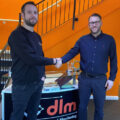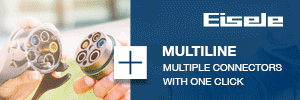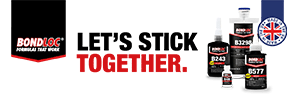The Magdalena Ridge Observatory Interferometer (MROI) will analyse the fringe patterns obtained from multiple pairs of combined beams to reconstruct an image of the target under observation such as imaging geostationary satellites to enhance space situational awareness. The system uses an Owl 640-II camera for SWIR imaging.
Long baseline optical interferometers are ground-based observatories that study the cosmos in high resolution at visible and infrared wavelengths. An interferometer works differently to conventional imaging telescopes. Starlight is captured with small telescopes that are separated from each other by distances up to a few hundred metres. The output of each telescope is a collimated beam around 10 cm in diameter. These beams are relayed towards a centralised laboratory where they are reduced in size to around 1 cm in diameter, then combined with beams from other telescopes to form interference fringes on a detector. By analysing the fringe patterns obtained from multiple pairs of combined beams, we can reconstruct an image of the target under observation.
The Magdalena Ridge Observatory Interferometer (MROI), depicted in Figure 1, is currently under construction at an altitude of 3100 m in New Mexico, USA. Once complete, it will harness ten 1.4 m-diameter telescopes to conduct observations at wavelengths from 600 nm to 2400 nm. It will be able to resolve features that would only be possible with a conventional optical telescope 350 metres in diameter (i.e. something that would be impractical to build).

Interferometric measurements are incredibly sensitive to the alignment of the pairs of beams being combined. For example, an angular drift of 10 µrad during observations is intolerable. An Automated Alignment System (AAS) has been developed for the MROI that will, prior to nightly observing, align the ten beamlines with minimal human interaction. As the night progresses, the AAS will correct thermally-induced drifts.

At the heart of the AAS is an alignment detector called BEASST that is placed in the beam combining laboratory. Similarly to a Shack-Hartmann sensor, it samples the beam pupil with a microlens array. A Raptor Owl 640-II is placed at the focal plane of the microlenses. Figure 4 displays typical image readouts from BEASST, which consist of an array of focal spots. Most beam alignment detectors can only measure either the angle or position of a collimated beam. In contrast, BEASST measures both parameters simultaneously. The beam angle is calculated from displacements of the focal spots while the beam position is determined from the centroid of the pupil intensity distribution.


The compact housing of the Raptor Owl 640-II allows ten BEASSTs to be placed in close proximity without
blocking the multitude of light beams that propagate in the laboratory. Its low power consumption is also helpful, since dissipated heat induces air turbulence that disturbs alignment on fast timescales. Furthermore, its optional compatibility with the GigE interface has been critical in our application in which the controlling computer is located far from the cameras. Multiplexing the ten cameras will be trivial since their images can be streamed to any PC connected to the network.

A prototype of BEASST was deployed at the Observatory. The Owl 640-II was essential for a number of commissioning measurements. For example, it was used to diagnose the collimation of an invisible reference light beam (see Figure 5). In another application it streamed images at 120 Hz to identify the cause of high frequency alignment disturbances (see Figure 6). Finally, it was used to detect stellar light in the beam combining laboratory for the first time (see Figure 7), which was an important milestone for the MROI.


The Magdalena Ridge Observatory Interferometer (MROI) project’s mission is to develop a ten-element imaging interferometer to operate at wavelengths between 0.6 and 2.4 microns with baselines from 7.8 to 340 meters. The technical and scientific goals are to produce model-independent images of faint and complex astronomical targets at resolutions over 100 times that of the Hubble Space Telescope. The goal of the MROI is threefold, to support programs in:
- Astronomy
- Space situational awareness
- Education & outreach
The astronomical science program includes the following three areas:
- Star and planet formation
- Stellar accretion and mass loss
- Active galactic nuclei’








